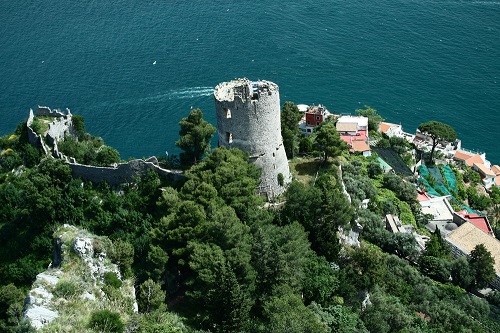
Immortalized in
The Duchess of Malfi, the masterpiece of Jacobean theatre which is still staged today, the tragic life of Duchess Giovanna D’Aragona comes to grisly life on the picturesque Amalfi coast during a visit to the Torre dello Ziro. This stately tower was one of many erected to keep watch for the Saracen pirates, who preyed upon the Ligurian coastline. Locals, however, prefer not to visit the tower, which they believe is haunted by Giovanna’s ghost.
John Webster’s play was first performed in 1614 at the Globe Theater by the King’s Men - later famed for staging most of Shakespeare’s plays. Like Shakespeare, Webster drew heavily on earlier versions of the real story of Giovanna, her second husband and children, and her greedy, power-hungry brothers to craft a classic Jacobean blood-soaked drama, with its signature clash of good against evil, dark against light, as well as the themes of corruption, class, the status of women, power and its abuses, and, most importantly, justice and revenge.
Giovanna D’Aragona was the daughter of a powerful nobleman, the Marquis of Gerace. She was married off at the age of twelve to strengthen Gerace’s political alliance with Alfonso, Duke of Amalfi. When Alfonso died five years later, Giovanna ruled Amalfi in his place. During this time, she fell in love with the master of her household, Antonio Bologna. Despite the difference in their positions in society, they secretly married and had three children, keeping their relationship private as only Giovanna’s maidservants had witnessed their wedding. Discretion was important, because Giovanna feared her powerful brothers Ludovico, the Cardinal of Santa Maria and Carlo d’Aragona, who had succeeded her father as Marquis of Gerace, would not approve of the match.
In Webster’s play, the brothers employ the duplicitous Bosola - one of English literature’s more complicated figures - to worm his way into Giovanna’s and Antonio’s confidence and spy on them. Bosola ultimately engineers Giovanna’s imprisonment and that of her two younger children in the Torre dello Ziro, and their subsequent deaths, but later repents and kills both the Cardinal and himself.
In real life, Giovanna was survived by her eldest son, who reigned as the Duke of Amalfi after her. In Webster’s play, this one child also escapes the blood-soaked slaughter, offering hope for concord and resolution.
But it still proves difficult to get someone local to show you the Torre dello Ziro.
Alexander+Roberts offer numerous ways to delve into the history and culture of Italy and the Amalfi coast, including our new
Amalfi Coast to Cinque Terre.